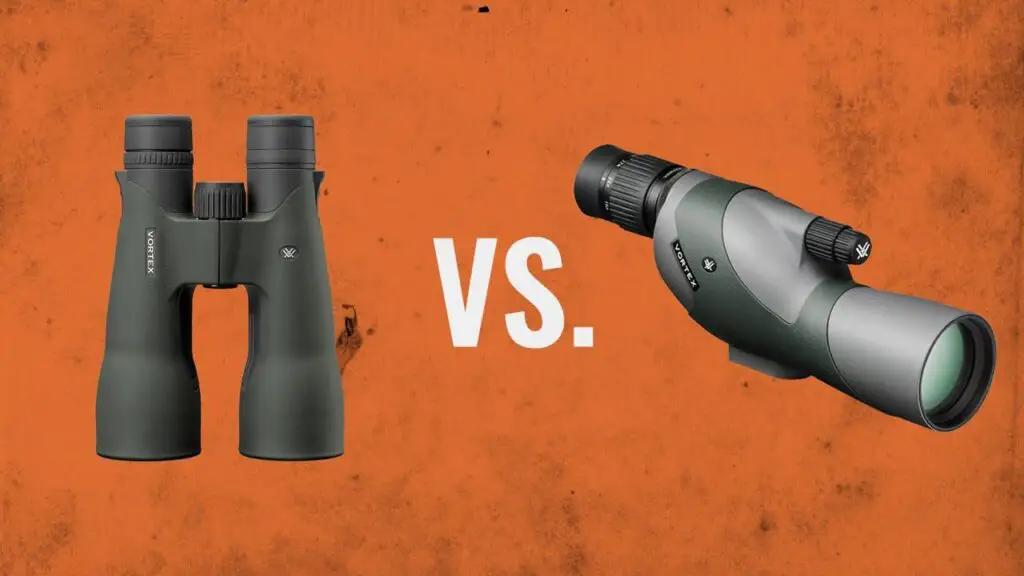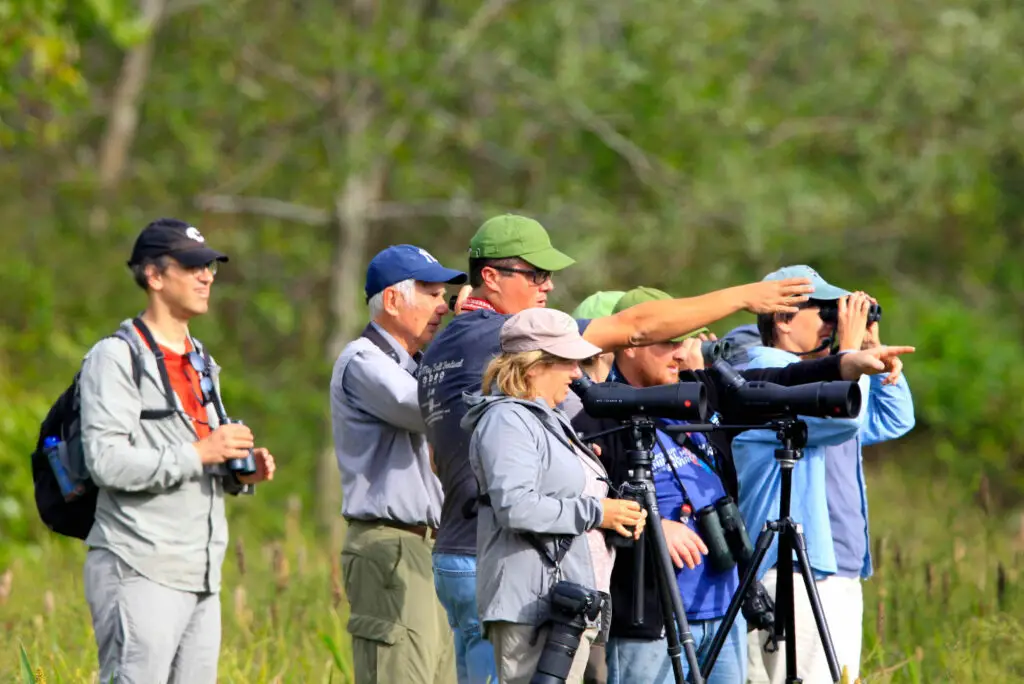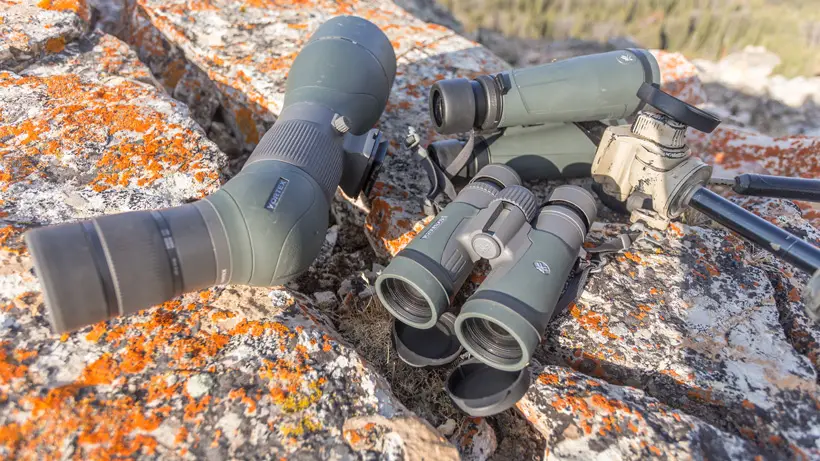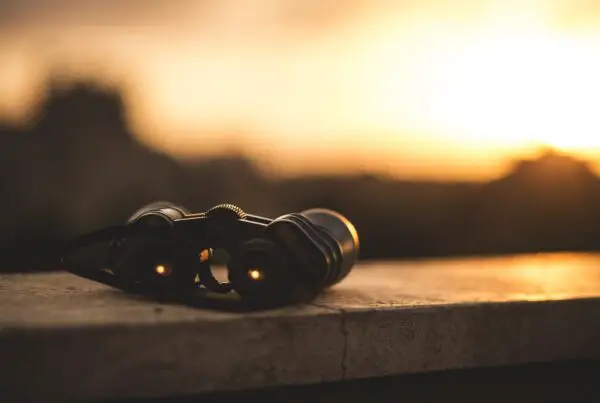Contents
Birding, the art of observing and identifying birds in their natural habitats, has captivated the hearts of nature enthusiasts for generations. To truly appreciate the beauty and intricacies of our feathered friends, having the right optical gear is essential.
Binoculars offer portability and a wider field of view, making them suitable for quick bird identification and scanning larger areas. Spotting scopes excel in higher magnification and detailed viewing at greater distances, but require additional investments and may be less convenient for extended use.
When it comes to choosing between binoculars and spotting scopes, birders often find themselves in a dilemma. Which one is better suited for this captivating hobby? Let’s delve into the details and unravel the strengths of each to help you make an informed decision.
The choice between binoculars and spotting scopes boils down to personal preferences. Some birders prioritize portability, convenience, and the ability to quickly scan vast areas, making binoculars their go-to choice. Others seek the power and magnification capabilities of spotting scopes to observe distant or stationary birds in exceptional detail.

Portability and Convenience:
When it comes to portability and convenience, binoculars have a clear advantage over spotting scopes. Their lightweight and compact design make them the perfect companion for birders on the move.
Binoculars are specifically designed to be portable, allowing you to embark on long walks, hikes, or even birding expeditions to remote locations. Their compact size and lightweight construction make them easy to carry without adding unnecessary bulk or weight to your gear. Whether you hang them around your neck with a comfortable strap or stow them in a small bag or backpack, binoculars are designed for effortless mobility.
Portability
The portability of binoculars is particularly advantageous when you’re exploring diverse habitats or venturing into rugged terrains. You can navigate uneven trails, climb hills, or traverse dense vegetation without feeling weighed down. The compact size ensures that you can move freely and enjoy your birding adventures without any hindrance.
Another notable benefit of binoculars is their quick accessibility. When birding, opportunities can arise unexpectedly, and the ability to swiftly bring your optical gear into action is crucial. Binoculars can be easily carried in your hands or hung around your neck, ready to be used at a moment’s notice. With just a simple raise of your eyes, you can instantly immerse yourself in the birding experience.
Convenience
The convenience of binoculars also extends to spontaneous birding opportunities. Whether you’re on a daily walk, exploring a new area, or simply enjoying a picnic in nature, you never know when a captivating bird might grace your presence. With binoculars within reach, you can seize these moments and appreciate the beauty of birds in their natural habitats.

Magnification and Distance Observation:
When it comes to magnification and observing birds at greater distances, spotting scopes take the lead over binoculars. Spotting scopes offer higher magnification capabilities, allowing birders to zoom in and study birds that are far away with exceptional detail.
Magnification
Spotting scopes are designed to provide powerful magnification, often exceeding the magnification range of binoculars. With spotting scopes, you can bring distant birds closer, revealing intricate details that may be difficult to discern with the naked eye or even with binoculars. This enhanced magnification opens up a whole new world of observation opportunities, especially when it comes to studying birds in expansive landscapes or observing species that tend to keep their distance.
One of the key advantages of spotting scopes is their ability to attach different eyepieces. This feature allows birders to customize the magnification level based on their specific needs and preferences. By simply swapping the eyepiece, you can adjust the magnification power of the spotting scope to suit different birding scenarios.
Whether you require a lower magnification for scanning larger areas or a higher magnification to focus on individual birds or specific details, spotting scopes offer the versatility to adapt to varying observation requirements.
While binoculars may struggle to provide the same level of magnification as spotting scopes, they still offer their own advantages in terms of field of view and ease of use.
Distance Observation
Spotting scopes are particularly useful for birders interested in stationary or distant birds. If you enjoy birding at coastal areas, where shorebirds feed and rest on distant shores, or in mountainous regions, where raptors soar high above, the higher magnification capabilities of spotting scopes become indispensable. Spotting scopes allow you to observe and appreciate the behavior, plumage, and features of these birds in remarkable detail, making every birding encounter a truly immersive experience.
However, when it comes to observing birds at greater distances and capturing finer details, spotting scopes are the ideal choice for birders who seek the ultimate in magnification capabilities and long-distance observation.

Field of View and Scanning Ability:
Field of View of Binoculars
One of the key advantages of binoculars is their wider field of view, which greatly aids in the scanning of larger areas and facilitates quick bird identification. Binoculars allow you to observe a broader expanse of the landscape, making it easier to locate and track birds as they move within their natural habitats.
The wider field of view provided by binoculars allows you to survey the surroundings more efficiently. When you’re birding in diverse habitats, such as forests, wetlands, or meadows, there’s often a rich tapestry of avian activity happening all around you. Binoculars enable you to take in the entire scene, capturing the movements of multiple birds simultaneously. This wider perspective is particularly valuable when birds are in flight or when you’re trying to locate specific species within a larger area.
Field of View of Spotting Scopes
On the other hand, spotting scopes have a narrower field of view compared to binoculars. This limitation means that you need to narrow your focus and observe a smaller portion of the landscape at a time.
While this may seem restrictive, it actually enhances your ability to concentrate on individual birds or specific details with great precision.
While spotting scopes may have a narrower field of view, they compensate for this by offering a more immersive and intimate viewing experience. They are particularly beneficial when observing birds that require close examination, such as shorebirds or raptors, or when studying specific behaviors that demand a higher level of detail.
Scanning Ability of Binoculars
The scanning ability of binoculars becomes essential when you’re exploring unfamiliar terrain or searching for elusive birds. By scanning systematically across the landscape, you can quickly cover a wide area and detect any signs of avian life.
Binoculars allow you to spot birds in motion, pick up on distinctive flight patterns, and identify species based on their behavior and field marks.
The wider field of view acts as a valuable tool for birders who enjoy observing birds in their natural habitats and appreciate the broader context of their surroundings.
Scanning Ability of Spotting Scopes
Spotting scopes excel in delivering detailed and close-up viewing experiences.
With their higher magnification capabilities, you can zoom in and observe birds with remarkable clarity and sharpness. Spotting scopes reveal the intricacies of plumage patterns, the nuances of behavior, and even the subtlest markings that may be challenging to discern with binoculars alone. They bring distant birds closer, allowing you to appreciate the fine details that make each species unique.
Also Check: 14 Best Birding Binoculars: Our Top Picks (Reviewed)
Image Quality and Optics:
Both binoculars and spotting scopes offer excellent image quality, thanks to advancements in optics technology. Optics manufacturers strive to deliver clear, sharp, and true-to-life images to enhance the birding experience.
When it comes to image quality, personal preferences play a significant role. Some birders may prioritize a wider field of view and a more immersive experience, favoring the image quality of binoculars. Others may value the ability to zoom in and observe birds in intricate detail, making the image quality of spotting scopes their top priority. Ultimately, the choice depends on individual preferences and the specific birding scenarios you anticipate encountering.
To determine the best image quality for your needs, it’s recommended to research and compare specific models and brands. Read reviews, consult with experienced birders, and visit local stores to test different optics firsthand. Look for features such as lens coatings, glass quality, and overall build quality, as these factors can significantly impact image clarity and sharpness.
Image Quality of Binoculars
Binoculars, despite their smaller size, can provide exceptional image quality. They often incorporate high-quality lenses, prisms, and coatings to ensure optimal light transmission and minimal distortion. Binoculars with similar specifications may have a slight advantage over spotting scopes due to their compact design, which allows for better control of light and reduced potential for image aberrations. This advantage is especially noticeable when using higher-end binocular models that are specifically designed for birding.
Image Quality of Spotting Scopes
Spotting scopes, on the other hand, are designed with larger objective lenses and higher magnification capabilities. This enables them to gather more light and deliver clear and detailed images even at long distances. Spotting scopes often utilize advanced lens coatings, such as ED (Extra-low Dispersion) or fluorite glass, to minimize chromatic aberration and ensure color accuracy. These features contribute to the exceptional image quality and clarity provided by spotting scopes.
Keep in mind: Image quality is a subjective aspect and can vary depending on the specific optics and personal preferences. What may be visually appealing to one birder may not be the same for another. By investing time and effort into researching and comparing various models, you can find the binoculars or spotting scope that meets your expectations and provides the image quality that brings you closer to the beauty of birds.

Cost Considerations:
When it comes to cost considerations, binoculars generally have the advantage of being more affordable compared to spotting scopes.
Binoculars are available in a wide range of price points, catering to different budgets and preferences. Whether you’re a beginner or a seasoned birder, there are binocular options that offer good image quality and performance without breaking the bank.
On the other hand, spotting scopes can be more expensive, especially when you factor in additional investments such as tripods and eyepieces. Spotting scopes with higher magnification capabilities and premium features often come at a higher price point. Additionally, tripods are essential for stabilizing and supporting spotting scopes, ensuring steady observation, and they can add to the overall cost.
Budget Consideration:
It’s important to consider your budget when deciding between binoculars and spotting scopes.
If you’re just starting out in birding or prefer a more casual approach, binoculars are a cost-effective option that can provide satisfactory performance for most birding scenarios.
You can find quality binoculars at various price ranges, allowing you to balance your budget and optical needs.
Spotting scopes, on the other hand, may require a larger investment, particularly if you’re seeking advanced features, higher magnification, or superior image quality. Additionally, tripods and additional eyepieces can add to the overall cost. It’s essential to consider the long-term commitment and financial implications associated with spotting scopes before making a purchase.
When making a decision, it’s important to assess your birding goals and the level of birding you plan to pursue.
If you’re an occasional birder or enjoy birding as a hobby, investing in a good pair of binoculars will often suffice. However, if you’re a dedicated birder who wants to study birds in great detail or observe distant species, a spotting scope may be a worthwhile investment despite the higher cost.
Ultimately, the choice between binoculars and spotting scopes should be based on your budget, the level of birding you plan to engage in, and your personal preferences. It’s recommended to do thorough research, read reviews, and, if possible, try out different models to find the optical equipment that offers the best balance of performance and affordability for your birding adventures.
Eye Comfort and Ergonomics:
Comfort and ergonomics should be a priority when selecting your birding equipment. Consider factors such as the weight and balance of the binoculars, the size and shape of the eyecups, and the adjustability of the interpupillary distance to ensure a comfortable fit. Some binocular models offer features like adjustable eyecups, which can be particularly beneficial for eyeglass wearers.
For Binoculars
When it comes to eye comfort and ergonomics, binoculars have a clear advantage over spotting scopes. Binoculars are designed to be used with both eyes, providing a more natural and comfortable viewing experience, especially during extended periods of use.
Using binoculars allows you to view birds with both eyes open, which promotes better depth perception and reduces eye strain. The binocular vision mimics our natural way of seeing, providing a more immersive and enjoyable birding experience. By using both eyes, you can also maintain a sense of balance and peripheral awareness, allowing you to observe your surroundings more effectively.
For Spotting Scopes
In contrast, using spotting scopes often requires using one eye for an extended period, which can lead to eye strain and fatigue. Constantly focusing with one eye while the other remains closed can cause discomfort, especially during long birding sessions.
The strain on the eye muscles and the lack of natural binocular vision can result in a less comfortable viewing experience.
When choosing between binoculars and spotting scopes, it’s crucial to prioritize your personal comfort and ergonomic preferences. Pay attention to how the equipment feels in your hands, how well it fits your face, and whether it allows for extended periods of use without discomfort. Opting for equipment that promotes natural and comfortable viewing will enhance your overall birding experience and reduce the risk of eye strain.
Ultimately, the choice between binoculars and spotting scopes should take into account your own comfort and ergonomic needs. While spotting scopes may have their advantages in specific situations, such as long-distance observations, if comfort and prolonged use are important factors for you, binoculars are likely the better option.
Also Check: 6 Best Sightseeing Binoculars: Our Top Picks (Reviewed)
Benefits:
Benefits of Binoculars
- Portability: Binoculars are lightweight and compact, making them easy to carry during long walks or hikes. Their portable nature allows for spontaneous birding opportunities, as they can be quickly accessed when birds are spotted.
- Wider Field of View: Binoculars offer a wider field of view, allowing you to scan larger areas and quickly locate birds. This broader perspective helps in identifying birds in their natural habitats and enhances the overall birding experience.
- Ease of Use: Binoculars are user-friendly and require minimal setup. They can be used with both eyes, providing a more natural viewing experience and reducing eye strain during prolonged observations. Binoculars also offer a quick and intuitive way to focus on birds.
Benefits of Spotting Scopes
- High Magnification: Spotting scopes have higher magnification capabilities than binoculars, allowing you to observe birds in greater detail, even at long distances. They provide clear and sharp images, making them ideal for birders who want to study intricate plumage patterns or observe elusive species.
- Detailed Viewing: Spotting scopes excel in delivering detailed and close-up views of birds. They allow you to zoom in and observe birds with exceptional clarity, revealing finer details that may not be easily visible with binoculars alone.
- Versatility: Spotting scopes have applications beyond birding. They can be used for activities such as wildlife observation, hunting, astronomy, and photography. Their high magnification and detailed viewing capabilities make them versatile tools for various outdoor pursuits.
Both binoculars and spotting scopes offer unique advantages, and the choice between them depends on individual preferences and specific birding scenarios. By understanding the benefits of each, you can make an informed decision and select the equipment that best suits your needs, enhancing your birding experiences and allowing you to appreciate the beauty of birds in their natural habitats.
Tips:
Here are some tips to consider when choosing between binoculars and spotting scopes for birding:
- Assess your birding goals: Consider the type of birding you plan to pursue. Are you primarily interested in quick identification and general observation, or do you want to focus on detailed and distant viewing? Understanding your goals will help you prioritize the features that matter most to you.
- Evaluate portability and convenience: If you anticipate long walks or hikes during your birding outings, consider the portability and weight of the equipment. Binoculars are typically lighter and more compact, making them easier to carry and quickly accessible for spontaneous birding opportunities.
- Consider viewing distance: If you’re interested in observing birds at greater distances or studying intricate details, spotting scopes with higher magnification capabilities might be a better choice. Spotting scopes allow you to zoom in and observe birds with exceptional clarity and sharpness.
- Assess the field of view: Binoculars offer a wider field of view, allowing you to scan larger areas and quickly identify birds in their natural habitats. Spotting scopes, while offering narrower fields of view, excel in delivering detailed and close-up views. Consider the trade-off between a broader perspective and a more focused, detailed observation.
- Budget and additional investments: Keep in mind the overall cost of the equipment. Binoculars are generally more affordable compared to spotting scopes, which may require additional investments such as tripods and eyepieces. Set a budget and consider the long-term financial implications before making a decision.
- Try before you buy: Whenever possible, test different models and brands to see how they feel in your hands and against your eyes. Visit local stores or attend birding events where you can try out various optics. This hands-on experience will give you a better sense of comfort, ergonomics, and image quality.
- Seek recommendations and read reviews: Reach out to experienced birders or join online birding communities to gather insights and recommendations. Reading reviews from reputable sources can also provide valuable information about specific models and brands, helping you make an informed decision.
Frequently Asked Questions (FAQ’s)
Q: Are binoculars or spotting scopes better for birding?
A: The choice depends on personal preferences and specific birding scenarios. Binoculars are more portable and offer a wider field of view, making them suitable for quick identification and scanning larger areas. Spotting scopes provide higher magnification and detailed viewing at greater distances, but may require additional investments and be less convenient for extended use.
Q: Can I use both binoculars and spotting scopes for birding?
A: Absolutely! Many birders use a combination of binoculars and spotting scopes. Binoculars are great for general observation and quick identification, while spotting scopes are ideal for detailed and distant viewing. Using both can enhance your birding experience by providing versatility and capturing a broader range of observations.
Q: Do I need a tripod for using a spotting scope?
A: While using a tripod with a spotting scope is not mandatory, it is highly recommended, especially for extended observations or higher magnifications. A tripod provides stability, reduces hand fatigue, and allows for more precise and steady viewing. It ensures a clear and shake-free image, particularly at longer distances.
Q: Can I use spotting scopes for other activities besides birding?
A: Yes! Spotting scopes have applications beyond birding and are widely used for activities such as wildlife observation, hunting, astronomy, and even photography. Their high magnification and detailed viewing capabilities make them versatile tools for various outdoor pursuits that require a closer look at distant subjects.9
Q5: What should I consider when choosing between binoculars and spotting scopes?
A: When making a decision, consider factors such as your budget, preferred birding environments, level of detail you want to observe, comfort during use, and your specific birding goals. Each option has its strengths, and it’s important to prioritize what matters most to you to make an informed choice that suits your individual needs.
Bottom Line
In summary, binoculars are the popular choice for most birders due to their portability, wider field of view, and ease of use. They are suitable for general birding and offer a good balance between magnification and portability. Spotting scopes are preferred when detailed and close-up views of birds are essential, especially for birders interested in long-range observation or for viewing in low-light conditions.

A Binoculars enthusiast, who love exploring skies and watching birds. It is my hobby to collect Binoculars of different kinds and try to explore the world through various lenses. This is all I do to explore happiness by magnifying my beautiful world.




